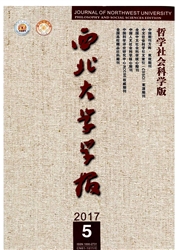

 中文摘要:
中文摘要:
从一种比较哲学视野出发,本文指出和西方一样,中国传统哲学中亦存在着一种“用具的形而上学”,与此同时,还为我们揭示出了中西“用具的形而上学”之间的根本区别;如果说西方传统的“用具的形而上学”的“用具”仅为“有用”的“用具”的话,那么中国传统的“用具”则体现为“备物致用”的“用具”(用器)与“备而不用”的“用具”(礼器)二者兼而有之;进而,如果说前者基于“用器”之用,以一种“道以器显”的方式而为我们更多地彰显了合乎“目的性”的“人”之道的话,那么,后者则基于“用具”的“用”与“无用”的二重性,以一种“道以器显”的方式,使中国哲学既走向了合乎“目的性”的“人”之道,又走向了“目的性”消解的“天”之道,而游刃有余、从容中道于“天”、“人”之间。无疑,中国哲学的“器”的二重性的揭示,不仅以一种体用不二的方式使其亦“天”亦“人”之道的哲学之谜得以破译,也为“器的文明”旗帜下的现代人类走出“人类中心主义”的困境,提供了一种可操作性的器用实践方式的借鉴。
 英文摘要:
英文摘要:
In the context of comparative philosophy, as this paper showed, similar to western philosophy, there is also a "metaphysics of utensil " in the Chinese philosophical tradition. Simultaneously, we disclosed the fundamen- tal difference between the two metaphysics. Unlike the utensil is only for use in western "metaphysics of utensil", it is not only a tool with usefulness but also a sacrificial vessel without utility in Chinese philosophy. In other words, the western "utensil" manifested the Dao of human which emphasizes the conformity to human aim forth. Mean- while, the Chinese "utensil" , which has an ambivalence between usefulness and uselessness, led the philosophy to a Human Dao, and also to a Heaven Dao, which deconstructed the purposiveness of human. This enables the Chi- nese philosophy to have plenty of room between Heaven and Human. Undoubtedly, the disclosing of the ambiva- lence of the "utensil" in Chinese philosophy solved the enigma why Chinese philosophy is both Heaven Dao and Human Dao. At the same time, it provided a practical way for the modem humans to get out of the jam of anthropo- centrism.
 同期刊论文项目
同期刊论文项目
 同项目期刊论文
同项目期刊论文
 期刊信息
期刊信息
